Steemit Engagement Challeng -S15/W2 | Stock to Flow Model
Hello everyone! I hope you are all doing well and enjoying life with the blessings of Allah Almighty. I am happy to take part in the exciting challenge hosted by SteemitCryptoAcademy community' Contest (ENG/ESP) Steemit Crypto Academy Contest / S15W2: Stock to Flow Model || Modelo Stock to Flow So, without any further delay, let's dive right in!
Explain in your own words the Stock to Flow Model, what is its function? |
|---|
The Stock to Flow model is like a crystal ball for predicting the Bitcoin prices. It checks how much new Bitcoin is made each year compared to the existing supply. Think of it like gold – the scarcer, the more valuable. This model helps estimate Bitcoin's future price based on its scarcity .
Assume you own a toy that is restricted in number. It is valuable because more people could want it if there are fewer available. Similar to this, the Stock to Flow model estimates the price of Bitcoin by examining its scarcity. People are curious as to whether this concept may be used to other currencies, such as STEEM, in addition to Bitcoin.
To predict the future value of Bitcoin, one can use the Stock to Flow model as a kind of code. The notion of scarcity—that something has greater value if it is difficult to obtain—is the central theme. By comparing the amount of new Bitcoin created annually to the entire supply, this model determines the scarcity factor of Bitcoin. If this might be extended to other currencies, such as our own STEEM, people are curious.

The Stock to Flow (S2F) model functions as a predictive tool for estimating the future value of assets, particularly Bitcoin.
It evaluates the connection between an asset's annual supply additions to the market and its current supply. This approach takes advantage of the idea that scarcity gradually increases value; it was inspired by commodities such as gold.
The S2F model forecasts the price trajectory by giving Bitcoin's scarcity a numerical value. Its purpose is to help analysts and investors make better decisions in the wild world of cryptocurrencies by giving them insights on possible price patterns & advancing knowledge of their economic dynamics.
What would be the advantages and disadvantages of the Stock to Flow Model? |
|---|
The advantages of Stock to Flow Model are following ;
Scarcity Measurement: The S2F model is a useful tool for quantifying the scarcity of assets like as Bitcoin, giving investors a clear way to evaluate its value. Making decisions is aided by its simplicity.
Historical Accuracy: The S2F model's proponents contend that its previous accuracy in predicting changes in BTc's price has strengthened the model's credibility as a forecasting tool.
Comparative Analysis: This model allows for the comparison of Bitcoin (BTc) to commodities like gold, providing investors with a familiar framework for evaluating its potential as a store of value.
Market Complexity: Critics argue that the S2F model oversimplifies the intricate cryptocurrency market by disregarding a numerous number of variables that could affect pricing, including shifts in regulations, advances in technology, & attitude in the market.
Assumption of Continuity: The model makes the assumption that stock and flow will always be related & that historical trends will continue. Under some circumstances, the model may become less dependable due to quick changes in market dynamics.
Limited Fundamental Analysis: Due to its primary focus on scarcity, the S2F model may fail to take over into account other important factors that impact an assets value, which could result in an in-adequate assessment of the state of the market.
Analysis of the Stock to Flow graph |
|---|
To grasp and interpret a graph effectively, it's crucial to comprehend how each individual element in graph contributes to the overall direction and meaning of the graph. Understanding these elements enhances graph analysis.
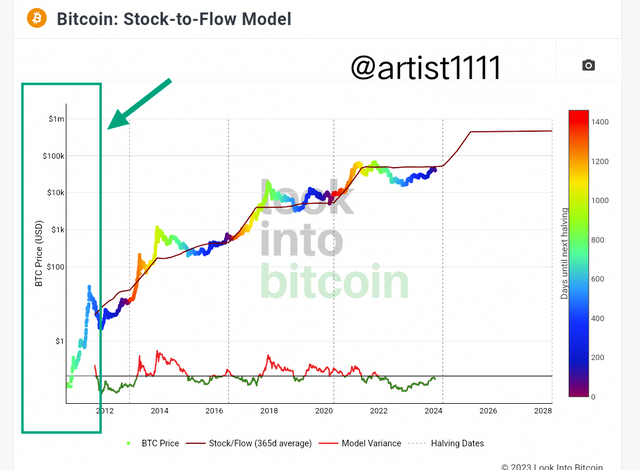 |
|---|
Examine the vertical axis depicting Bitcoin prices, ranging from $1 to $1 million. Gain a clear understanding of the price movement by focusing on this axis, which delineates the cryptocurrency's value across the entire spectrum, from the lower end of $1 to the upper extreme of $1 million.
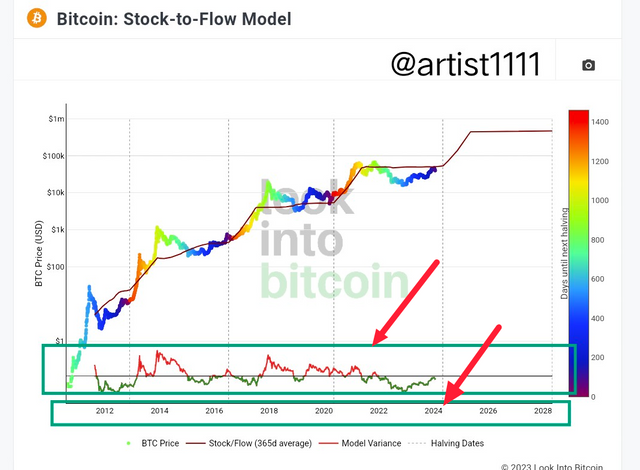 |
|---|
There are two horizontal axes below. One shows annual data from 2012 to 2024, giving a running chronological summary of Bitcoin's performance. Above this, a second axis shows the graph's oscillations, showing Bitcoin's upward and downward motions.
When combined, these axes provide a thorough visual depiction that illustrates the dynamic nature of Bitcoin price fluctuations as well as the annual data's chronological evolution.
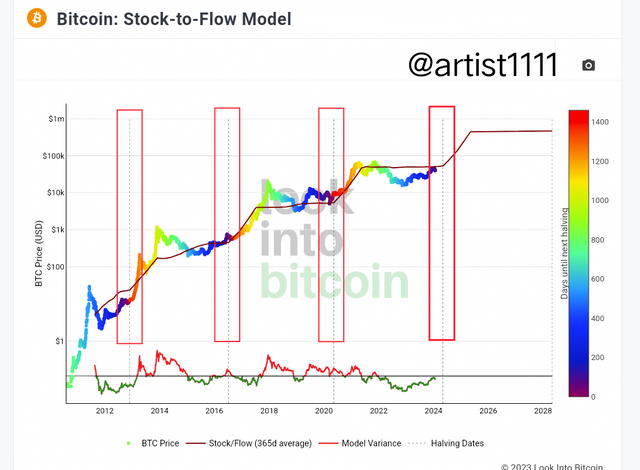 |
|---|
The graph's dotted line represents Bitcoin halving occasions. This graphic component indicates precise moments in time when the price for discovering new Bitcoin blocks is cut in half, which affects the quantity of the cryptocurrency and can have an effect on its price dynamics.
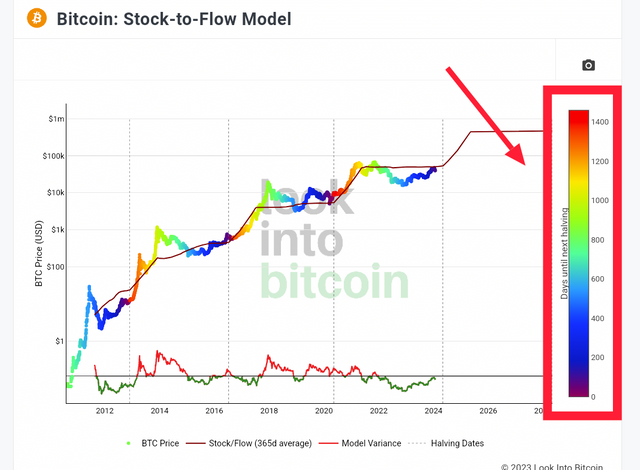 |
|---|
Days with varying colors on the right side represent Bitcoin halving occasions. With a vertical table that represents 1400 days, a thorough timeline is provided. Every color in the table probably represents a certain stage or feature associated with the halving of Bitcoin, offering a visual aid for monitoring trends and alterations over time.
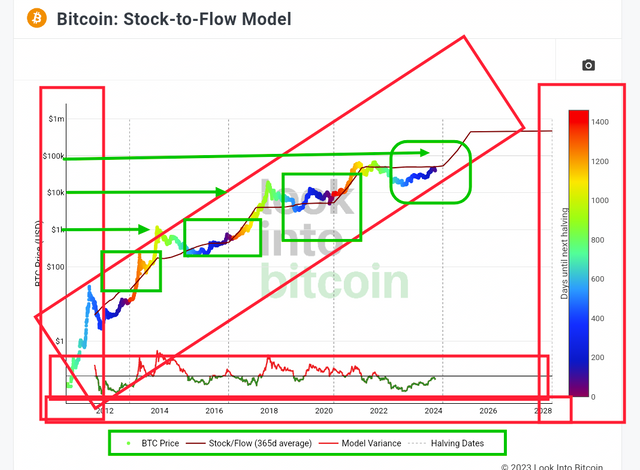 |
|---|
When looking at the graph data, possible links with price fluctuations are suggested by the color-coded days that indicate Bitcoin halving occasions. Patterns and trends can be found by applying technical analysis to the graph that shows years 2012 through 2024. Halving events are correlated with notable price swings, suggesting a potential influence on supply dynamics and market sentiment.
These results can be further interpreted by using the Stock to Flow model. Examining how scarce Bitcoin is in relation to its price history both before and after halving events could provide light on how the cryptocurrency's value has changed.
The model's previous predictive power of Bitcoin price swings lends credence to its applicability. Investors may be able to better comprehend the variables affecting Bitcoin prices and make wise choices in the volatile cryptocurrency market by combining these analyses.
Can this model be applied to STEEM? Give reasons why this Stock to Flow graph model can or cannot be applied. |
|---|
The Stock to Flow (S2F) model application to STEEM has concerns and obstacles. For assets with a limited supply, such as Bitcoin, where scarcity is a key value driver, the approach is naturally suited. On the other hand, STEEM functions through a distinct process, wherein the token supply is dynamic and subject to inflation, based on several criteria such as content generation and curation.
- Reasons why it may not be directly applicable to STEEM:
Dynamic Supply: In comparison to Bitcoin, STEEM has fixed supply of tokens thanks to features like inflation and incentives for content producers. The S2F model's fixed supply premise is broken by this dynamic supply structure.
Utility Differences: STEEM functions as a social media platform built on the blockchain, with a value system based on content generation and network involvement. This utility-driven feature is in opposition to the S2F model's emphasis on the store of value narrative for assets like Bitcoin.
Market Perception: As STEEM and Bitcoin have different use cases and tokenomics, the market's sense of scarcity and value for each may be different.
In conclusion, because STEEM is powered by utilities and has a dynamic supply, it may not fit neatly into the Stock to Flow model, which was designed for assets with fixed supplies. Customized analytical methods are required due to the distinctive features of every cryptocurrency.
In summary, whereas the Stock to Flow (S2F) model works well for determining scarcity in fixed-supply assets such as Bitcoin, there are issues with applying it directly to STEEM. STEEM deviates from the S2F model in that its token supply is dynamic, driven by curation and content production.
A straight comparison is made more difficult by the utility-centric design of STEEM, which functions as a social media network built on blockchain technology. Each cryptocurrency has unique characteristics that investors and analysts should be aware of.
They should also emphasize the need for specialized analytical frameworks in order to understand and forecast the market dynamics and value propositions of each cryptocurrency.
With Best Regards
@artist1111
Goodbye, friends. It's been a pleasure getting to know you all participating in this community. I will miss interacting with all of you, but it is time for me to move on. Take care & I hope to see you all again very soon , Best of Luck .
As the sun sets on the day
And the night falls softly in
We close this chapter, dear reader
But the story's not yet done
Tomorrow's pages wait, unwritten
INTRODUCTION
As the sun sets on the day
And the night falls softly in
We close this chapter, dear reader
But the story's not yet done
Tomorrow's pages wait, unwritten
INTRODUCTION


Saludos cordiales gran amigo artist1111, un gusto para mi saludarte y leer tu participación.
Maravillosa explicación del stock to flow, un método predictivo que se encarga de dar un estimado de la revalorarizacion del BTC.
Te deseo muchos éxitos, que tengas un feliz y bbendecido día.
Thanks for the warm words and support! ¡Saludos cordiales! Te deseo éxito y días llenos de bendiciones.
This publication has been supported through the Steemcurator06 account for containing good quality content.

Curated by: @suboohi
Love a lot to reading more information about the Stock to Flow from your post. Please keep it up broo
Thanks for the encouragement! I'll continue sharing insights on the Stock-to-Flow model.
My pleasure 😊
@artist1111
Yes you are right the stock to flow model is another and you clearly stated that it should be seen as gold meaning the lower the number the higher its value and the lack of bitcoin. It also helps to predict its future based on the other if you mentioned a toy that there is a toy that is limited in number so people will want it more and more people will buy it. It will be bought and its price will increase and it will increase. It means that they are limited in number and if you talk about it, you have explained all their location in unity and your post is definitely appreciated. Best wishes for the competition doing the best.
Thanks for the detailed understanding! I'm glad the analogy resonated. Best wishes in the competition!
@artist1111 I enjoyed reading your detailed explanation of the Stock-to-Flow model. Your analogy of Bitcoin scarcity to owning a limited toy was spot-on and made the concept so clear. Best of luck
Thanks for the kind words! Explaining concepts with relatable analogies is crucial.
You've provided a comprehensive analysis of the differences between STEEM and Bitcoin, especially in terms of dynamic supply, utility, and market perception.
Great and in-depth explanation!!
Thanks for recognizing the analysis! Delving into the nuances helps clarify distinctions between STEEM and Bitcoin.
Greetings friend,
You're absolutely right about the stock-to-flow model. Let us think of it in a simple every day life setting like, if there's a limited edition toy that everyone wants, the fewer there are, the more valuable they become. As more people buy it, the demand increases, driving up the price. The same goes for Bitcoin, as its scarcity makes it more valuable, therefore the S2F model is solely based on calculating this scarcity ratio and how it affects the Bitcoin price.
Your post on this topic is really appreciated. Good luck in the competition.
Thanks for the thoughtful reflection! Simplifying with relatable examples makes understanding the S2F model clearer.
Upvoted. Thank You for sending some of your rewards to @null. It will make Steem stronger.
La bola de cristal que permite pronosticar el precio futuro del BTC parece ser el modelo S2F cuyo fundamento principal es la escasez. Cuando hablamos de escasez, también hablamos de halving de BTC, una reducción que induce la escasez cada 4 años y que resulta esencial en la economía de este ecosistema.
Estoy de acuerdo en las dificultades para aplicar el modelo a STEEM dado el dinamismo del suministro del token impulsado por la participación de sus usuarios y la curación en la red, característica que están fuera del alcance del modelo S2F.
Haz abordado completamente las pautas del desafío, aportando conocimientos a los usuarios.
¡Te deseo mucho éxito y un feliz día!